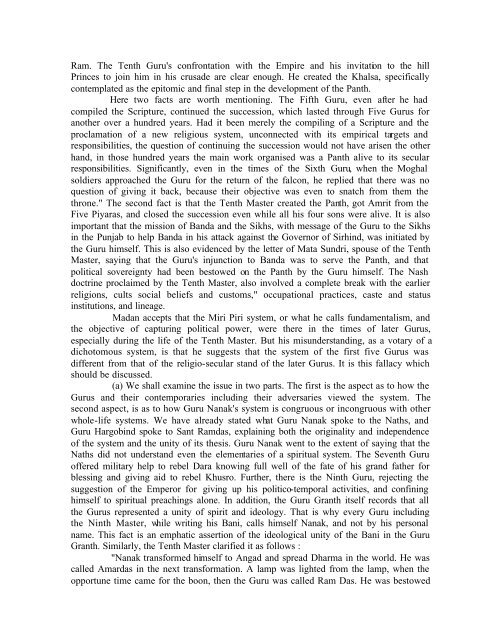Fundamentalism and the Sikh Religious Tradition by T.N. Madan
Fundamentalism and the Sikh Religious Tradition by T.N. Madan
Fundamentalism and the Sikh Religious Tradition by T.N. Madan
You also want an ePaper? Increase the reach of your titles
YUMPU automatically turns print PDFs into web optimized ePapers that Google loves.
Ram. The Tenth Guru's confrontation with <strong>the</strong> Empire <strong>and</strong> his invitation to <strong>the</strong> hill<br />
Princes to join him in his crusade are clear enough. He created <strong>the</strong> Khalsa, specifically<br />
contemplated as <strong>the</strong> epitomic <strong>and</strong> final step in <strong>the</strong> development of <strong>the</strong> Panth.<br />
Here two facts are worth mentioning. The Fifth Guru, even after he had<br />
compiled <strong>the</strong> Scripture, continued <strong>the</strong> succession, which lasted through Five Gurus for<br />
ano<strong>the</strong>r over a hundred years. Had it been merely <strong>the</strong> compiling of a Scripture <strong>and</strong> <strong>the</strong><br />
proclamation of a new religious system, unconnected with its empirical targets <strong>and</strong><br />
responsibilities, <strong>the</strong> question of continuing <strong>the</strong> succession would not have arisen <strong>the</strong> o<strong>the</strong>r<br />
h<strong>and</strong>, in those hundred years <strong>the</strong> main work organised was a Panth alive to its secular<br />
responsibilities. Significantly, even in <strong>the</strong> times of <strong>the</strong> Sixth Guru, when <strong>the</strong> Moghal<br />
soldiers approached <strong>the</strong> Guru for <strong>the</strong> return of <strong>the</strong> falcon, he replied that <strong>the</strong>re was no<br />
question of giving it back, because <strong>the</strong>ir objective was even to snatch from <strong>the</strong>m <strong>the</strong><br />
throne." The second fact is that <strong>the</strong> Tenth Master created <strong>the</strong> Panth, got Amrit from <strong>the</strong><br />
Five Piyaras, <strong>and</strong> closed <strong>the</strong> succession even while all his four sons were alive. It is also<br />
important that <strong>the</strong> mission of B<strong>and</strong>a <strong>and</strong> <strong>the</strong> <strong>Sikh</strong>s, with message of <strong>the</strong> Guru to <strong>the</strong> <strong>Sikh</strong>s<br />
in <strong>the</strong> Punjab to help B<strong>and</strong>a in his attack against <strong>the</strong> Governor of Sirhind, was initiated <strong>by</strong><br />
<strong>the</strong> Guru himself. This is also evidenced <strong>by</strong> <strong>the</strong> letter of Mata Sundri, spouse of <strong>the</strong> Tenth<br />
Master, saying that <strong>the</strong> Guru's injunction to B<strong>and</strong>a was to serve <strong>the</strong> Panth, <strong>and</strong> that<br />
political sovereignty had been bestowed on <strong>the</strong> Panth <strong>by</strong> <strong>the</strong> Guru himself. The Nash<br />
doctrine proclaimed <strong>by</strong> <strong>the</strong> Tenth Master, also involved a complete break with <strong>the</strong> earlier<br />
religions, cults social beliefs <strong>and</strong> customs," occupational practices, caste <strong>and</strong> status<br />
institutions, <strong>and</strong> lineage.<br />
<strong>Madan</strong> accepts that <strong>the</strong> Miri Piri system, or what he calls fundamentalism, <strong>and</strong><br />
<strong>the</strong> objective of capturing political power, were <strong>the</strong>re in <strong>the</strong> times of later Gurus,<br />
especially during <strong>the</strong> life of <strong>the</strong> Tenth Master. But his misunderst<strong>and</strong>ing, as a votary of a<br />
dichotomous system, is that he suggests that <strong>the</strong> system of <strong>the</strong> first five Gurus was<br />
different from that of <strong>the</strong> religio-secular st<strong>and</strong> of <strong>the</strong> later Gurus. It is this fallacy which<br />
should be discussed.<br />
(a) We shall examine <strong>the</strong> issue in two parts. The first is <strong>the</strong> aspect as to how <strong>the</strong><br />
Gurus <strong>and</strong> <strong>the</strong>ir contemporaries including <strong>the</strong>ir adversaries viewed <strong>the</strong> system. The<br />
second aspect, is as to how Guru Nanak's system is congruous or incongruous with o<strong>the</strong>r<br />
whole-life systems. We have already stated what Guru Nanak spoke to <strong>the</strong> Naths, <strong>and</strong><br />
Guru Hargobind spoke to Sant Ramdas, explaining both <strong>the</strong> originality <strong>and</strong> independence<br />
of <strong>the</strong> system <strong>and</strong> <strong>the</strong> unity of its <strong>the</strong>sis. Guru Nanak went to <strong>the</strong> extent of saying that <strong>the</strong><br />
Naths did not underst<strong>and</strong> even <strong>the</strong> elementaries of a spiritual system. The Seventh Guru<br />
offered military help to rebel Dara knowing full well of <strong>the</strong> fate of his gr<strong>and</strong> fa<strong>the</strong>r for<br />
blessing <strong>and</strong> giving aid to rebel Khusro. Fur<strong>the</strong>r, <strong>the</strong>re is <strong>the</strong> Ninth Guru, rejecting <strong>the</strong><br />
suggestion of <strong>the</strong> Emperor for giving up his politico-temporal activities, <strong>and</strong> confining<br />
himself to spiritual preachings alone. In addition, <strong>the</strong> Guru Granth itself records that all<br />
<strong>the</strong> Gurus represented a unity of spirit <strong>and</strong> ideology. That is why every Guru including<br />
<strong>the</strong> Ninth Master, while writing his Bani, calls himself Nanak, <strong>and</strong> not <strong>by</strong> his personal<br />
name. This fact is an emphatic assertion of <strong>the</strong> ideological unity of <strong>the</strong> Bani in <strong>the</strong> Guru<br />
Granth. Similarly, <strong>the</strong> Tenth Master clarified it as follows :<br />
"Nanak transformed himself to Angad <strong>and</strong> spread Dharma in <strong>the</strong> world. He was<br />
called Amardas in <strong>the</strong> next transformation. A lamp was lighted from <strong>the</strong> lamp, when <strong>the</strong><br />
opportune time came for <strong>the</strong> boon, <strong>the</strong>n <strong>the</strong> Guru was called Ram Das. He was bestowed
















